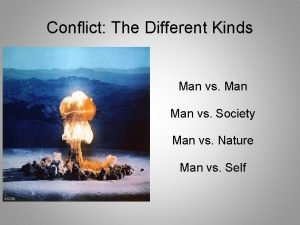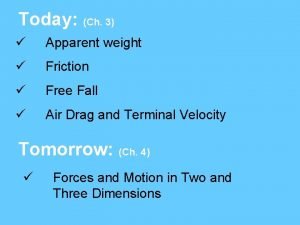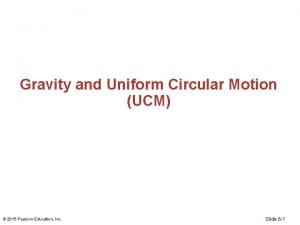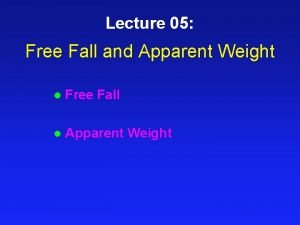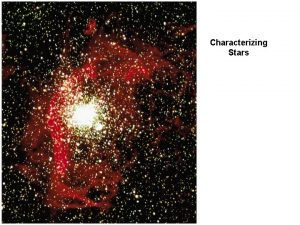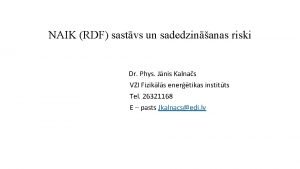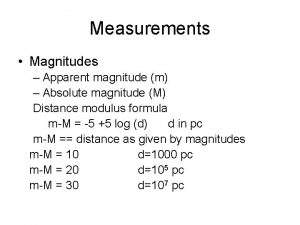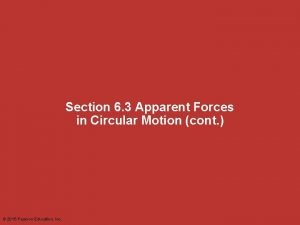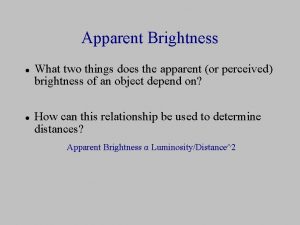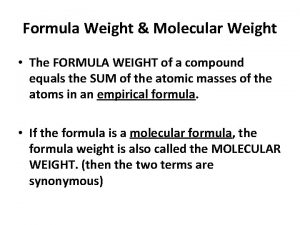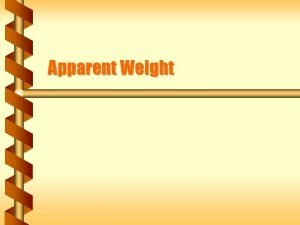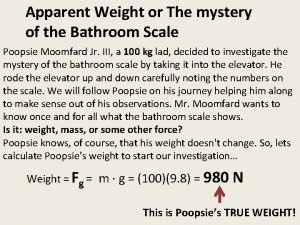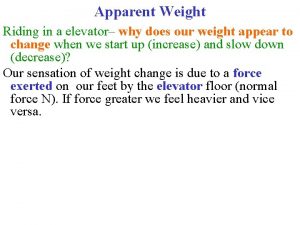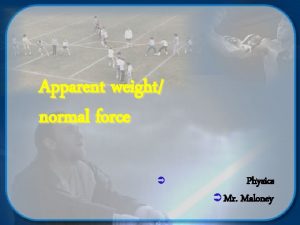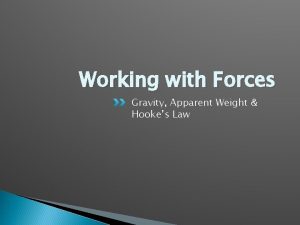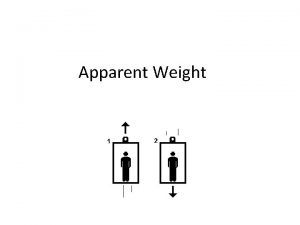Apparent Weight A 75 kg man is standing






















- Slides: 22

Apparent Weight

» A 75 kg man is standing on a scale in an elevator. The elevator is at rest. What is the reading on the scale (in Newtons)? Warm-Up Scale

» A 75 kg man is standing on a scale in an elevator. The elevator is at rest. What is the reading on the scale (in Newtons)? FN scale on man FW earth on man Scale Warm-Up Scale FN = FW read ing t h ig e W e u r T ) (mg

» A 75 kg man is standing on a scale in an elevator. The elevator accelerating upwards. Does the reading on the scale (apparent weight) change? If so, how? FN scale on man a FW earth on man Apparent weight Scale

» A 75 kg man is standing on a scale in an elevator. The elevator accelerating downwards. Does the reading on the scale (apparent weight) change? If so, how? FN scale on man a FW earth on man Apparent weight Scale

» A stack of books whose true weight is 165 N is placed on a scale in an elevator. The scale reads 165 N. From this information alone, can you tell whether the elevator is moving with a constant velocity of 2 m/s upward, is moving with a constant velocity of 2 m/s downward, or is at rest? Example 1 Scale

» A 10 kg suitcase is placed on a scale that is in an elevator. In which direction is the elevator accelerating … » when the scale reads 75 N? » When the scale reads 120 N? Example 1 Scale

» DOES NEWTON’S THIRD LAW PREVENT THE HORSE FROM MOVING THE WAGON? » Noah Formula notes that Newton's Third Law says that if I pull on the wagon, the wagon exerts an equal and opposite force on me. He believes that if these two forces are equal and opposite, they will cancel, so that the net force is zero. If the net force is zero, then Newton's Second Law (and Newton's First Law, too) says that the acceleration of the wagon must be zero, so the wagon can never move. ? ?

» An object accelerates (or not) because of the forces that push or pull on it. (Newton's 2 nd Law) » Only the forces that act on an object cancel. Forces that act on different objects don't cancel because they affect the motion of different objects! ? ?

» What are the Newton's Third Law Force Pairs? » 1. The two forces colored yellow in the diagram are a Newton's Third Law force pair - "horse pulls wagon" and "wagon pulls horse". They are equal in magnitude and opposite in direction. » 2. The two forces colored blue in the diagram are a Newton's Third Law force pair - "horse pushes ground" and "ground pushes horse". They are also equal in magnitude and opposite in direction. ? ?

» Friction Force = a contact force between two surfaces. It results from the electromagnetic force due to interactions between molecules of the two surfaces. » Frictional forces are parallel to the surfaces, and in a direction opposite to the motion of the objects. » Friction depends upon how hard the surfaces are pressing against each other (the normal force) and the rough/smoothness of the surfaces in contact. Friction

» Static Friction – The magnitude, fs, of the static frictional force can have any value from zero up to a maximum value of fs. MAX, depending on the applied force. Demo – wood blocks

» fs. MAX = μs. FN » μs is the coefficient of static friction (describes the roughness of the two surfaces in contact) » FN is the magnitude of the normal force (tells how hard the surfaces are pressing together) Static Friction

» Static friction is essential – for example rock climbing, walking, a car moving on the road. . . Static Friction

» Once two surfaces begin sliding over one another, the static frictional force is no longer of any concern. » Kinetic friction comes into play. » Kinetic frictional force opposes the relative sliding motion. Kinetic Friction

» fk = μk. FN » μk is the coefficient of kinetic friction » fk is independent of the area of contact between the surfaces » is independent of the speed (if speed is small). » Is proportional to the Normal force Kinetic Friction

» μk is usually less than μs » Kinetic friction is typically less that static friction » It takes less force to keep an object sliding across a floor than it takes to get it going in the first place. Kinetic Friction

Kinetic Friction When two surfaces are moving with respect to one another, the frictional resistance is almost Index constant over a wide range of low speeds, and in the standard model of friction the frictional force is described by the relationship below. The coefficient is typically less than the coefficient of static Friction friction, reflecting the common experience that it is easier to keep something in motion across a concepts horizontal surface than to start it in motion from rest. Kinetic Friction

» A skier is standing motionless on a horizontal patch of snow. She is holding onto a horizontal tow rope which will soon pull her forward. Her mass is 59 kg and the coefficient of static friction between her skis and the existing snow is 0. 14. What is the magnitude of the maximum force that the tow rope can apply to the skier without causing her to move? » 80. 95 Newtons Example 1

» A horse is pulling a plow along a field. The coefficient of kinetic friction between the plow and the dirt is. 45 and the mass of the plow is 75 kg. » a) Find the frictional force exerted on the plow. » b) Find the frictional force exerted on the dirt. » a) 330 N » b) -330 N (the opposite direction) Example 2

» A sled and its rider are moving at a speed of 4. 0 m/s on a horizontal stretch of snow. The sled is moving to the right. The snow exerts a kinetic frictional force on the sled runners so the sled slows down and eventually stops. The coefficient of kinetic friction is 0. 050. » a) Draw the free body diagram. » b) What is the displacement of the sled? Use kinematics! Example 3

» A sled and its rider are moving at a speed of 4. 0 m/s on a horizontal stretch of snow. The sled is moving to the right. The snow exerts a kinetic frictional force on the sled runners so the sled slows down and eventually stops. The coefficient of kinetic friction is 0. 050. » a) 16. 3 m Example 3
 Man vs society pictures
Man vs society pictures A man of weight 75 kg is standing
A man of weight 75 kg is standing How to find apparent weight
How to find apparent weight How to find apparent weight
How to find apparent weight Apparent weight
Apparent weight A car turns a corner on a banked road
A car turns a corner on a banked road Apparent weight formula elevator
Apparent weight formula elevator Buoyant force
Buoyant force Difference between standing crop and standing state
Difference between standing crop and standing state Tolerable weight is a body weight
Tolerable weight is a body weight Bulk reducing product example
Bulk reducing product example Last man standing phrase
Last man standing phrase Draw the power triangle
Draw the power triangle Ecologyu
Ecologyu Apparent magnitude
Apparent magnitude Apparent brightness
Apparent brightness Apparent density
Apparent density Période de révolution
Période de révolution Example of apparent competition
Example of apparent competition Redshift formula
Redshift formula How to calculate specific gravity
How to calculate specific gravity Rarefraction
Rarefraction A physics textbook swings back and forth as a pendulum
A physics textbook swings back and forth as a pendulum
